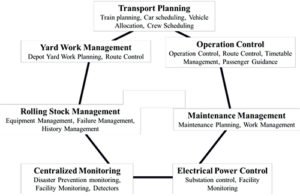Computer Aided Centralized Traffic Control System
The centralized traffic control (CTC) system is an integral part of any railway system. Though this system controllers can control the movement of traffic from a central location through the use of sensors and levers for changing the position of switches. For systems without Automatic braking, wrong commands by the traffic controller could result in accidents, but with the automatic braking system, the CTC is not a critical safety component. Nonetheless, it is essential for maintaining the reliability of the services.

Figure 1 Overview of the ATC system (Source : 2)
However, in the Japanese system, the system does a lot more than just traffic control. An overview of the full functionality of the Computer Aided Centralized Traffic control system is shown in Figure 2. Under this system, a group of controllers in a centralized location can manage the entire railway operations. Each of the controllers in the group is responsible for functions such as Rolling Stock Management, Ma intenance management , Electrical Power Control, Centralized Disaster Monitoring, and Yard Work management. They coordinate effectively with the Operation Controller to issue changes to manage timetables for regular operations and operations under disturbance. The snapshot of the entire system helps the Operation Controller to flexibly assign rolling stock sets, crew, etc. to a specific train.
Moreover, the operation controller can also issue guidance to passengers for their connecting trains, etc. helping passengers maneuver easily when the service is disturbed (thus improving their satisfaction). One key feature of this system is its integration with Transport Planning. The transport planning department plans for long (5-10 years)- and medium-term (Yearly) traffic demand. The information available (Real-Time) from this centralized system helps the planning department ensure the timely procurement of the supply for various assets as well as Human Resources either through maintenance or through new purchase. It is this integration with the demand planning that ensures that there is sufficient focus on asset maintenance and not just on service increase. Thus, the need for the hour for the Indian system is to develop such large-scale centralized data management systems which ensure smooth information flow across departments, resulting in efficiency in decision making.
Condition Based Maintenance
As discussed previously, the HSR system requires an intensive focus on maintenance. The high-capacity utilization of the infrastructure generates enormous pressure on assets, and if not maintained, it will quickly lead to a large number of service failures and safety issues. In Japan, a system of night-maintenance is implemented.
Under this system, the trains do not operate from 12:00 am to 6:00 am and maintenance works are executed. Every morning, a test train confirms the clearance for the path before the commencement of the regular operations. Even in Japan, maintenance is labor intensive and comprises of a large amount out of total investments of the company. Given that in India, a similar maintenance strategy is likely to exist, the need for India is to develop cost-effective maintenance methods that can help ensure service reliability.
For the HSR to deliver on its promises of the safe, punctual, and reliable mode of transportation is only possible when the Indian industry can steadily supply low-cost, highquality technical products
As opposed to the classic periodic maintenance method, in which maintenance activity is performed on an asset after a fixed period, the Japanese system uses Condition Based Maintenance (CBM), in which an asset is maintained as per its real conditions. The CBM is shown to result in substantial cost savings, as it helps in resource allocation optimization.
 TrafficInfraTech Magazine Linking People Places & Progress
TrafficInfraTech Magazine Linking People Places & Progress


